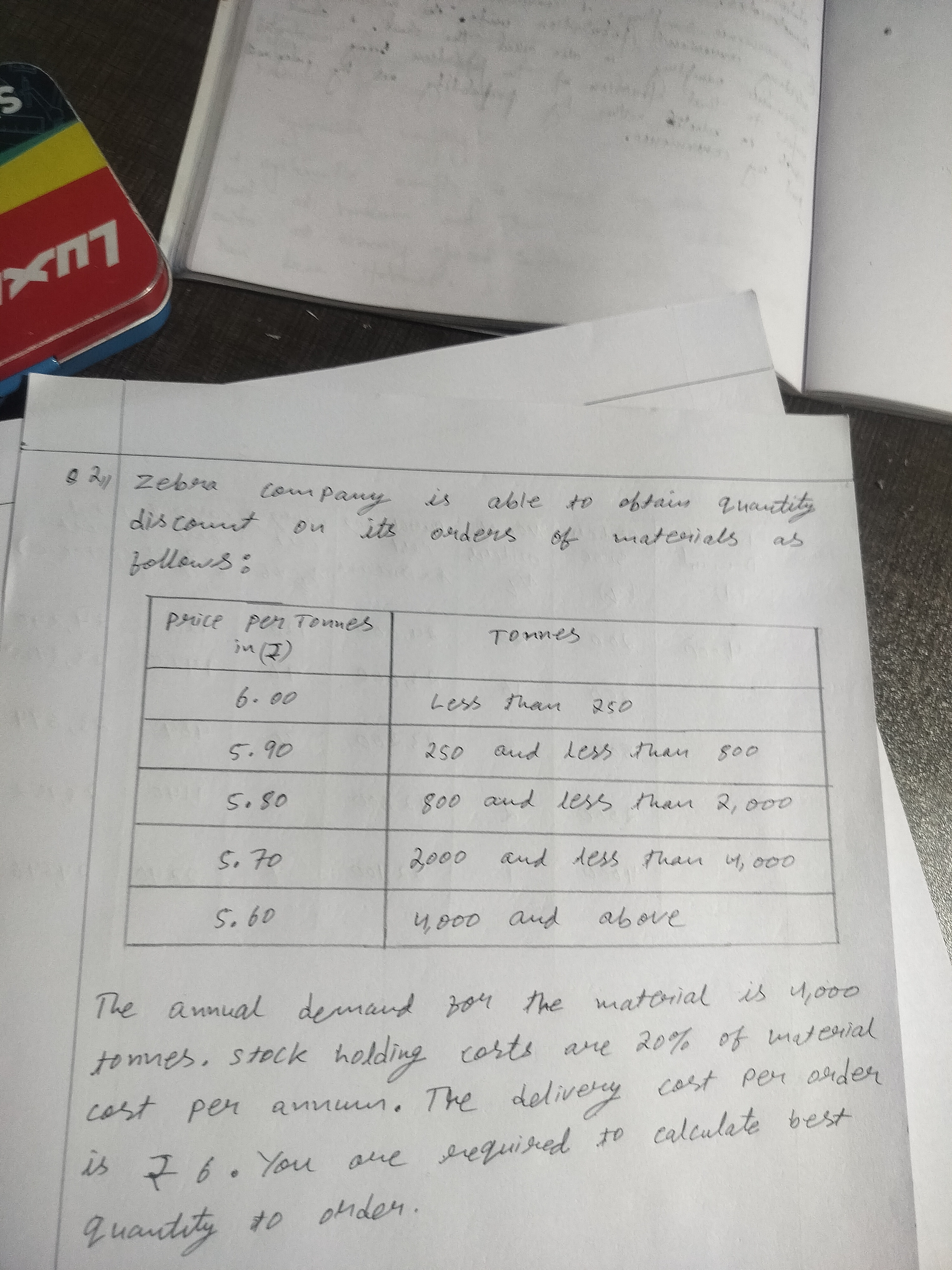Zebra company is able to obtain quantity discount on its orders of materials as follows: Price per tonnes (in ₹): 6.00 for less than 250 tonnes, 5.90 for 250 and less than 500 tonn... Zebra company is able to obtain quantity discount on its orders of materials as follows: Price per tonnes (in ₹): 6.00 for less than 250 tonnes, 5.90 for 250 and less than 500 tonnes, 5.80 for 800 and less than 2000 tonnes, 5.70 for 2000 and less than 4000 tonnes, and 5.60 for 4000 and above. The annual demand for the material is 4000 tonnes, stock holding costs are 20% of material cost per annum, and the delivery cost per order is ₹6. You are required to calculate the best quantity to order.

Understand the Problem
The question is asking to calculate the best quantity to order for Zebra Company based on their discount structure and annual demand. This involves using inventory management techniques, likely applying the Economic Order Quantity (EOQ) model, factoring in stock holding costs and delivery costs.
Answer
The best quantity to order is the EOQ that achieves the lowest total cost, based on the given price structure and costs.
Answer for screen readers
The best quantity to order is determined by the EOQ that yields the lowest total cost, which requires further calculations for exact numbers.
Steps to Solve
- Identify Constants and Variables
The annual demand ($D$) is 4,000 tonnes. The stock holding cost is 20% of the purchase price per tonne, and the delivery cost per order is ₹6.00.
- Calculate Holding Cost per Tonne
Determine the holding cost for each price tier:
-
For ₹6.00: $$ \text{Holding Cost} = 0.20 \times 6.00 = ₹1.20 $$
-
For ₹5.90: $$ \text{Holding Cost} = 0.20 \times 5.90 = ₹1.18 $$
-
For ₹5.80: $$ \text{Holding Cost} = 0.20 \times 5.80 = ₹1.16 $$
-
For ₹5.70: $$ \text{Holding Cost} = 0.20 \times 5.70 = ₹1.14 $$
-
For ₹5.60: $$ \text{Holding Cost} = 0.20 \times 5.60 = ₹1.12 $$
- Calculate Economic Order Quantity (EOQ)
Use the EOQ formula: $$ EOQ = \sqrt{\frac{2DS}{H}} $$ where:
- $D = 4000$ tonnes,
- $S = 6.00$ (cost per order),
- $H$ is the holding cost calculated above for each price tier.
Calculate EOQ for each price tier.
- Compare Total Costs
For each order quantity (EOQ), calculate the total cost: $$ \text{Total Cost} = \left(\frac{D}{Q}\right)S + \left(\frac{Q}{2}\right)H + PD $$ where:
- $P$ is the price per tonne based on the EOQ tier,
- $Q$ is the EOQ calculated.
- Select Optimal Order Quantity
Choose the EOQ that results in the lowest total cost.
The best quantity to order is determined by the EOQ that yields the lowest total cost, which requires further calculations for exact numbers.
More Information
The Economic Order Quantity (EOQ) helps managers minimize total inventory costs by calculating the optimal order size and taking discounts into account. Choosing the right order quantity can save money in terms of holding and ordering costs, and it can effectively manage inventory levels.
Tips
- Forgetting to update holding costs based on the price tier.
- Not including total costs in calculations for each price bracket, focusing solely on EOQ.
- Misapplying the EOQ formula or using incorrect data values.
AI-generated content may contain errors. Please verify critical information